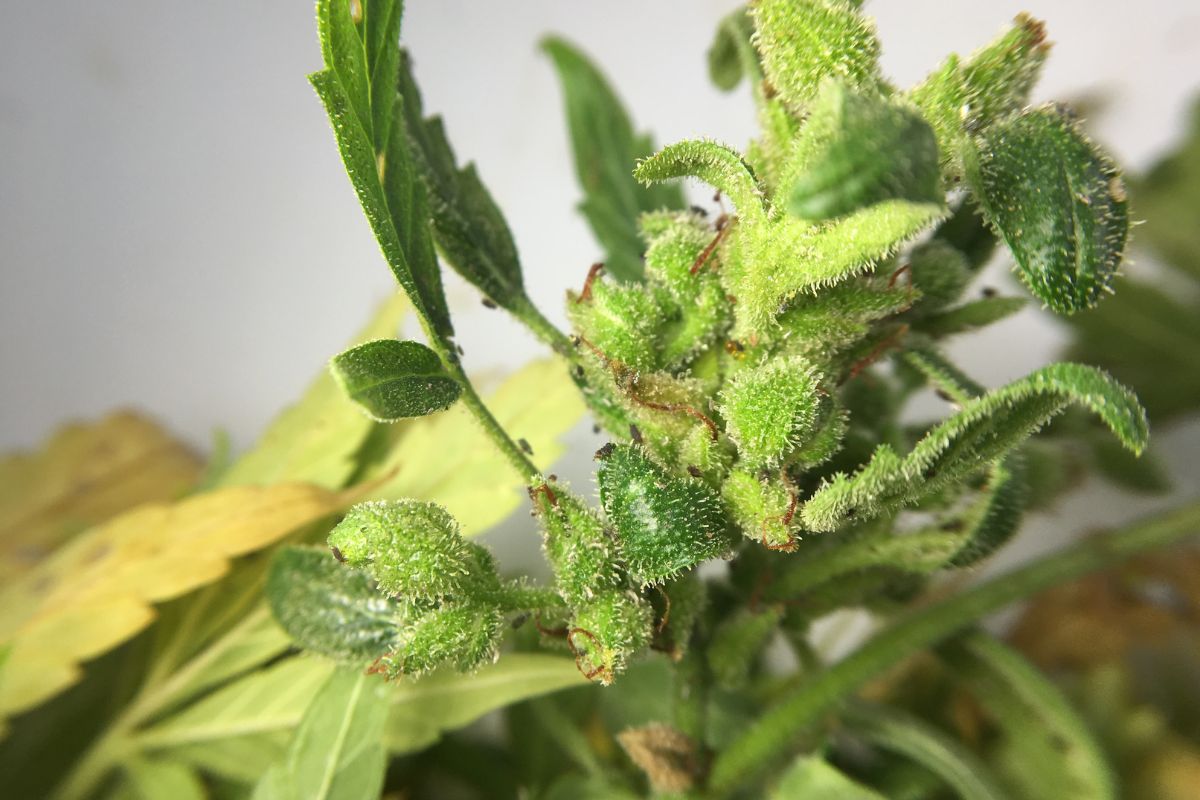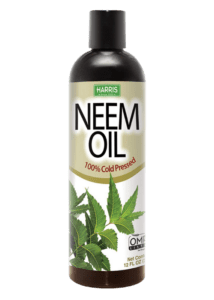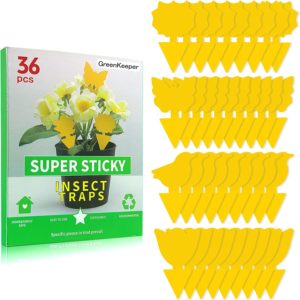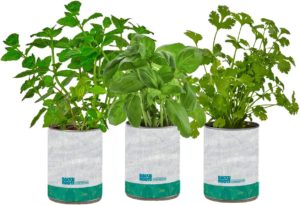Key takeaways:
- Cannabis pests include aphids, mites, thrips, caterpillars, and more.
- Pests can cause damage to cannabis plants by feeding on leaves, flowers, and buds.
- Pests can also transmit diseases to plants through a bacterial spread.
- Cannabis growers can use a variety of methods to prevent and control pests, including mechanical controls, biological controls, and chemical controls.
Cannabis pests are tiny creatures that can cause big problems for growers. These pests can damage plants by feeding on leaves, flowers, and buds. Some pests also transmit diseases, which can reduce yields and even kill plants.
Thankfully, there are a variety of ways to prevent and control pests. In this article, we’ll discuss the most common cannabis pests, how to identify them, and the best ways to control them.

Early identification is key for cannabis pest prevention. Both indoor and outdoor growers should be equally aware of how to identify pests on cannabis leaves and the common indoor and outdoor pest management tactics.
Navigating pests starts the moment you start setting up your growing space. From the cleanliness of the room to soil quality, it all counts. Creating a strong root system with high-quality soil helps naturally defend against predators. Just like humans, your plant’s immune system will dictate how pests and other invasives will impact them.
In this article, we will cover common pests and how to identify and offer indoor and outdoor solutions for pest management.
Cannabis pests identification: How to identify pests on cannabis plants
Our eyes will become our pest friends during this process. Most of the time, we can identify pests early on by looking for small wormholes, eggs, or larvae. Cannabis pests will be tiny and hard to spot without careful examination with a magnifying glass.
The key mitigation strategy is simply becoming the most observant grower with a trained eye to identify pests from the get-go. This means carefully observing leaves (from top to bottom) every time you water and ensuring growing conditions are as clean as possible. Remember many pests can be unseen without a magnifying glass, which makes an essential tool for growers.
5 Most Common Cannabis Pests and How to Identify
Here are some of the common cannabis pests that most growers should look out for. Specific pests will also be determined by your region and environment, so research your area for more information.
Careful observation and inspection are the best tools for mitigation. It is always advised to use a microscope when doing your inspection, as many pests and insects can be invisible to the naked eye, especially earlier on in the process.
Always check both sides of the leaf, and look for any white or dark spots, fuzzy patches, and irregularities.
Aphids
An aphid infestation can be a real headache and can spread and reproduce at a rapid rate. Cannabis aphids can be present both on the plant leaves and in the roots in both indoor and outdoor environments. They typically feed on the leaf sap and can be found usually under the leaf. Aphids can be found among the leaves, soil, and in preflowers and buds. Look for dry yellowish leaves.

Control method: Aphids can be treated by introducing predator insects that feed on their larvae, such as parasitic wasps, ladybird beetles, or lacewing larvae. Aphids can also be treated with insecticidal soaps and essential horticultural oils such as neem oil.
Caterpillars
Caterpillars also referred to as Inchworms and Leafrollers are the larvae of moths and butterflies. They can cause significant damage to cannabis plants, eating leaves and causing them to become ragged and damaged.
Control method: The best way to control caterpillars is to introduce natural predators, such as wasps, into your grow space. You can also remove them by spraying them with water or using an organic insecticide.
Crickets
Crickets are small, brown insects that are known for their “chirping” sound. Crickets can cause damage to cannabis plants by eating leaves, stems, and flowers.
Control method: The best way to control crickets is to introduce natural predators, such as frogs, into your grow space. You can also remove them by spraying them with water or using an organic insecticide.
Fungus Gnats
Fungus Gnats are small flies that feed on fungi and organic matter in the soil. Adult fungus gnats often resemble small mosquitos and will typically develop through four stages. They thrive in damp, dark, and humid environments.
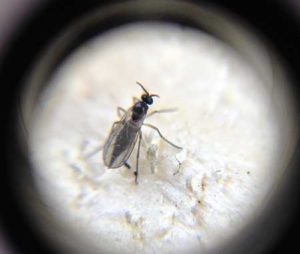
Control method: The best way to control fungus gnats is to introduce natural predators, such as parasitic WASPS, into your grow space. You can also remove them by spraying them with water or using an organic insecticide. Fungus gnats can also be treated with diatomaceous earth and yellow sticky traps can help with early identification and limit the numbers.
Grasshoppers
Grasshoppers are large, green insects that are known for their ability to “jump” long distances. Grasshoppers can cause significant damage to cannabis plants by eating leaves, stems, and flowers.
Control method: The best way to control grasshoppers is to introduce natural predators, such as praying mantises, into your grow space. You can also remove them by spraying them with water or using an organic insecticide.
Hemp Russet Mites
Hemp russet mites are one of those pests that can only be seen with a magnifying glass. Hemp mites or Russet mites are tiny, spider-like mites that feed on plant tissue. Hemp mites cause a wide range of damage to cannabis plants, including distortion of new growth, leaf curling, and eventual plant death. Hemp russet mites can lead to stunting and smaller bud size so it’s important to identify them early!
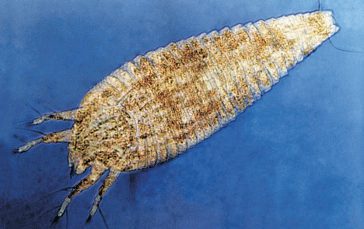
Symptoms of hemp russet mites can also resemble the symptoms of mold, overwatering, and nutrient deficiencies (which is why it’s so important to use a magnifier to inspect your plants). Symptoms include leave curling and dead buds.
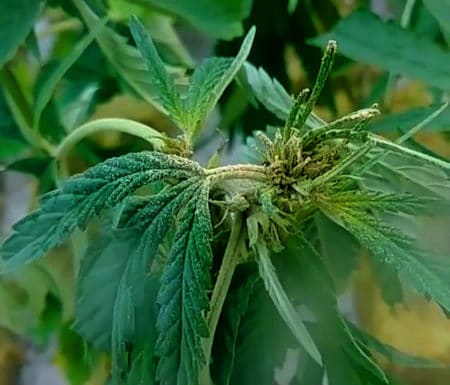
Control method: The best way to control hemp mites is to introduce natural predators, such as predatory mites, into your grow space. You can also remove them by spraying them with water or using an organic insecticide or with micronized sulfur diluted in water.
Hoppers
Leafhoppers and planthoppers are small insects that are known for their ability to “jump” long distances. They can cause damage to cannabis plants by eating leaves, stems, and flowers.
Control method: The best way to control leafhoppers and planthoppers is to introduce natural predators, such as ladybugs, into your grow space. You can also remove them by spraying them with water or using an organic insecticide
Leaf miners
Leaf miners are small insects that tunnel through leaves, causing damage and eventually killing the leaf. Leaf miners can quickly damage a cannabis plant if left unchecked.
Control method: The best way to control leaf miners is to introduce natural predators, such as parasitic wasps, into your grow space. You can also remove them by spraying them with water or using an organic insecticide.
Mealybugs
Mealybugs are small, wingless, white insects that gather in colonies and secrete a waxy substance over their bodies. They puncture cannabis leaves to suck out the plant’s sap, which can cause leaves to yellow and wilt. Mealybugs can also spread mold and mildew.
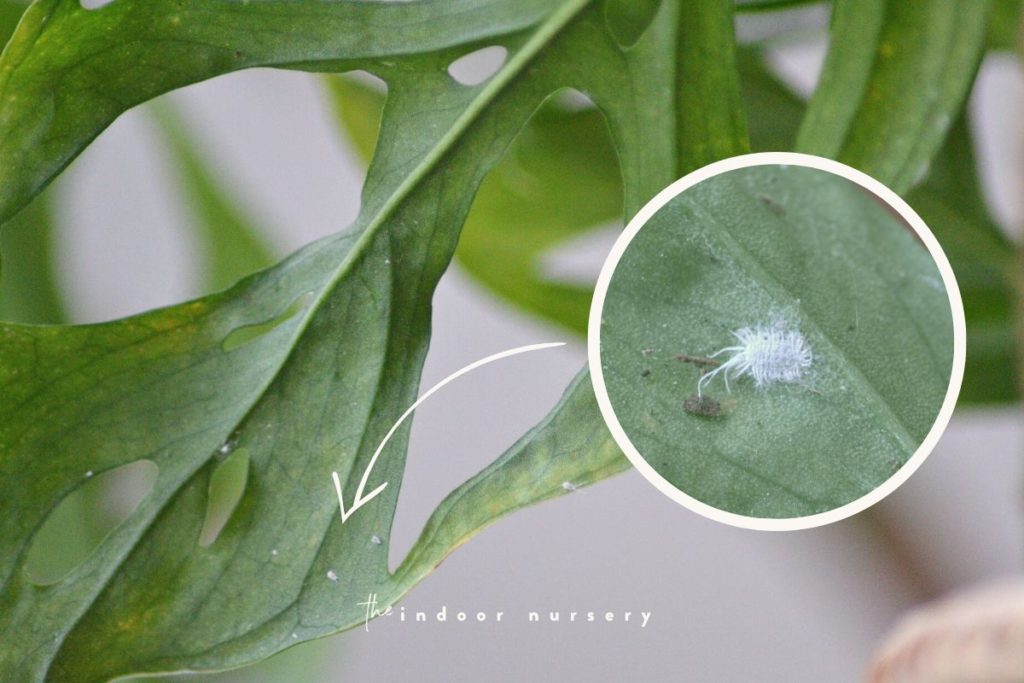
Control method: The best way to control mealybugs is to introduce natural predators, such as ladybugs, into your grow space. You can also remove them by spraying them with water or using an organic insecticide.
Psyllids
Psyllids are small, winged insects that feed on plant sap. They can cause damage to cannabis plants by eating leaves, stems, and flowers.
Control method: The best way to control psyllids is to introduce natural predators, such as ladybugs, into your grow space. You can also remove them by spraying them with water or using an organic insecticide.
Slugs and snails
Slugs and snails are soft-bodied creatures that glide across wet surfaces. They can cause significant damage to cannabis plants by eating leaves, stems, and flowers.
Control method: The best way to control slugs and snails is to introduce natural predators, such as toads, into your grow space. You can also remove them by spraying them with water or using an organic insecticide.
Red Spider Mites
Luckily, red spider mites are easier to identify due to their greenish-brown coloring and can be found on both sides of the leaves. They typically will feed from the upper part and lay their larvae on the bottom (similar to white flies). Spider mites thrive in warm climates and can be found indoors and outdoors (typically during the spring and summer).
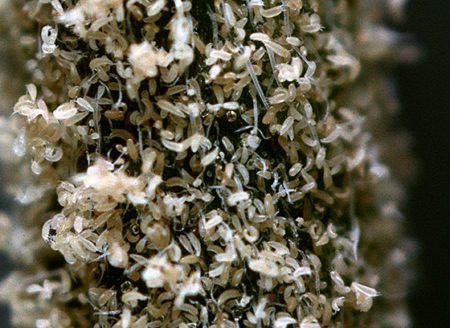
Control Method: To treat red spider mites, flush the soil with a mixture of alcohol and soap. Or introduce predatory species like ladybugs or lacewings.
Scale
Scale insects are small, wingless insects that secrete a waxy substance over their bodies. They puncture cannabis leaves to suck out the plant’s sap, which can cause leaves to yellow and wilt. Scale insects can also spread mold and mildew.
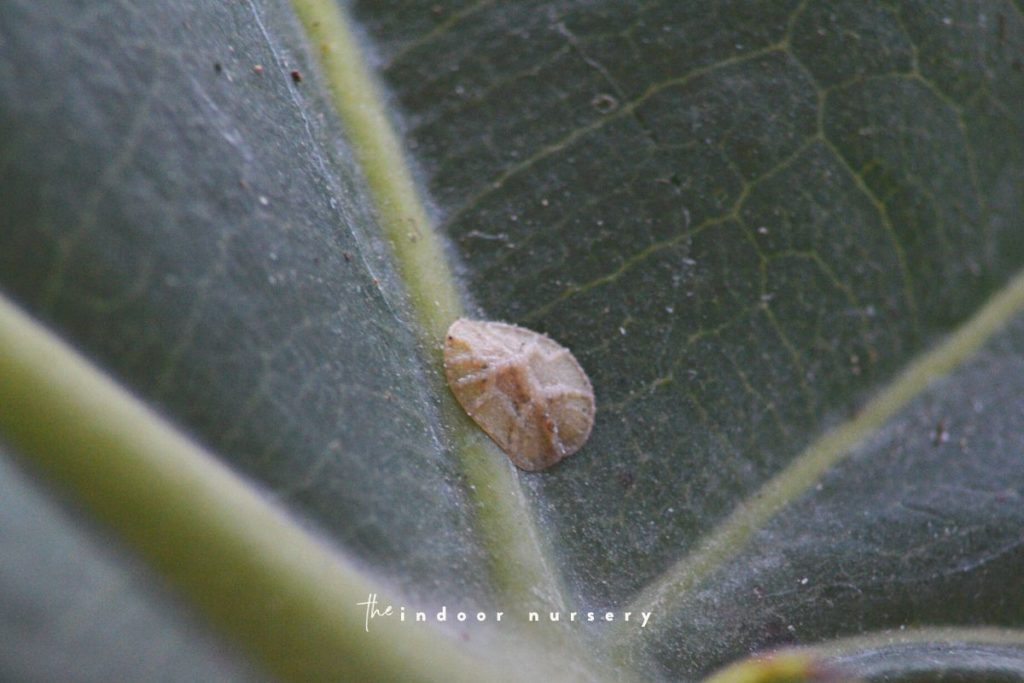
Control method: The best way to control scale insects is to introduce natural predators, such as ladybugs, into your grow space. You can also remove them by spraying them with water with rubbing alcohol and picking them off manually. We have a whole entire series all about dealing with scale if you want some more details on how to do it.
Thrips
Thrips are tiny pale worms that love to get their nutrient fix from cannabis leaves. Thrips will leave leaves with a shiny, slimy, and silver or bronze coloring.

Control method: The best way to control thrips is to introduce natural predators, such as ladybugs, into your grow space. You can also remove them by spraying them with water or using an organic insecticidal soaps, neem oil, or Diatomaceous Earth.
Whiteflies
Whiteflies are small, white insects that are known for their ability to “fly” short distances. They can cause damage to cannabis plants by eating leaves, stems, and flowers.
Control method: The best way to control whiteflies is to introduce natural predators, such as ladybugs, into your grow space. You can also remove them by spraying them with water or using an organic insecticide.
How to control pests in outdoor cannabis
When you grow outdoors, you are going to take some losses and that’s just the name of the game. Nature will always be in charge and it is best to plan accordingly and strategically. By making strategic moves before planting, starting with the soil health then we can better ensure our plants will have a healthy defense mechanism against pesky invaders.
For outdoor growers, pest management may seem daunting and impossible to truly control. However, there are many organic and natural mitigation tactics that can help you ensure your plants survive all phases of development from the flowering stage to harvest, chemical and pest free.
Tips for Outdoor Cannabis Pest Management
Use Sterilized Soil
As discussed, the health of your soil is the foundation for a healthy plant. For small growers, it is worth looking into sterilizing your soil by cooking in the oven to reach 180F. This will subsequently kill all molds, pests, weeds, and seeds. Be very careful to not go over 180F when sterilizing your soil. For more information check out this article on sterilizing the soil.
Introduce Natural Predators
All outdoor growers should be well aware of the myriad of natural pest predators that can help you from the get-go. Ladybugs are highly beneficial insects to keep around your outdoor plants as they love to feast on pests and insect larvae. Ladybugs are especially keen on the infamous spider mites that lurk amongst us. Ladybugs are also a cheap organic alternative, you can find them online for roughly $5 per 100.

Grow Companion Plants
Another organic and natural method for outdoor cannabis pest control is growing companion plants. Basil offers a strong scent that repels thrips, beetles, aphids, and other insects. Garlic is a great cannabis companion as it is a natural fungicide and can also be used as a spray for spot treatment (it also leaves beneficial species like ladybugs).
If you are worried about nitrogen deficiency, planting beans near your cannabis plants will help deposit extra nitrites into the soil which builds your plant’s immune system and natural resistance to pests.
Marigolds similar to basil have intense aromatics and are more attractive to pests (a beautiful distraction). Some growers even recommend planting a “virtual fence” of protection of marigolds around your cannabis plants for an extra level of protection.
Natural Organic Pesticides & Repellants
Organic pest control is always the first route growers should take. It is always best to remember that cannabis is made for consumption so every ingredient will ultimately influence the final flavors and outcome. Here are a few natural & organic pesticides and repellents to use in the future.
Diatomaceous Earth Spray
Diatomaceous Earth is a natural mineral powder derived from the earth and can be used in its powder form. DE is great for spider mites and any other pests. Sprinkle DE on top of the plants and in the leaves or combine the following ingredients in a spray bottle. DE is great for spider mites, aphids, and fungus gnats (amongst many other pests).
- 1-2 tablespoons Diatomaceous Earth
- 1 quart of filtered or distilled water
Neem Oil Spray
Neem oil is one of the most common natural ingredients used to ward off cannabis pests and insects. Neem oil is a naturally occurring pesticide found in the seeds of the neem tree. Azadirachtin it is another natural remedy to ward off pests. Combine the following ingredients in a misting bottle consisting of:
- 1 teaspoon neem oil
- 1 teaspoon Dr. Bronner’s liquid soap
- 1 quart of filtered or distilled water
Netting/Fencing
For those bigger pests like birds, netting and fencing can help with pest management. Placing a net around the perimeter will keep birds out. Building a fenced perimeter will additionally help with keeping larger pests and animals out.
How to prevent pests on indoor cannabis plants
As one can imagine, indoor pest management is a bit easier to control than outdoor. However, once these indoor pests have made their home they can be hard to remove. Indoor plants require a lot of maintenance in terms of sanitization and soil conditioning. There are various methods to follow to ensure your indoor plant is safe from invaders.
Tips for Indoor Cannabis Plant Pest Management
Maintain High Sanitary Standards
Indoor growers must keep their indoor grow room as clean and organized as possible. Ensure there is no water runoff or any messes that will attract pests. Indoor environments with high humidity or lack of air circulation are more prone to pests. Keep it clean and under control. The proper sanitization of your grow space should be in tip-top shape, always. Your plants should be attended to daily with the highest maintenance requirements.
Create Exceptional Soil Conditions
Cannabis bugs and pests are most likely brought in through the soil or attracted to the conditions of your soil. Pests love humid and wet areas where they can grow and feed. Keeping indoor plants pest-free requires the grow room to be as clean and controlled.
Detect Pests Early
Carefully observe and inspect your plants using a magnifying glass as many pests cannot be seen by the naked eye. Inspect your plants as much as you water them. Don’t get lazy!
Use Yellow Sticky Traps
Yellow Sticky traps are a great no-fuss way to identify various pests early on and limit their numbers. Simply place sticky traps around plants in the soil or on grow room wall.
FAQ
What are the white bug pests on cannabis plants?
Whiteflies or aphids are the most common white pests on marijuana plants. With a microscope, carefully observe both sides of the bud leaves. They will typically hide under the leaf to suck on the incoming nutrients. The best organic options for white
Whiteflies can be eliminated with insecticidal soaps or neem oil. Look for tiny white pesticides on the leaves. The best organic solution is using neem oil or diatomaceous earth.
What pests do ladybugs eat cannabis from?
Ladybugs are a grower’s best ally for treating various pests like white aphids and spider mites. One ladybug can eat up to 60 aphids in one day and when used in large quantities is even more effective.
Lady bugs are also generalist predators meaning they will feed off a range of pests both indoors and outdoors and will work at any stage of the cannabis grow cycle. When sourcing ladybugs, buy native species as some species can be invasive.
How quickly do cannabis pests breed/spread?
Pests breed and spread as quickly as every 24 to 72 hours. Breeding cycles will vary from pest to pest. Spider mites, for example, have a 3 to 5 days egg hatching time. One female will lay a total of 60-100 eggs.
How to control bugs and pests on cannabis organically?
For organic growers, there are many organic options to control bugs and pests such as neem oil, doctor zymes, and diatomaceous earth powder. In addition, growers can plant companion plants and predatory species are regulating measures. Raw milk can be an extremely effective way to get rid of pests and strengthen your plant’s root system.
What pests eat the edges of cannabis leaves?
Caterpillars, snails & slugs, and leaf miners love to chew on the edges of cannabis leaves. Caterpillars can be treated with parasitic wasps or praying mantises. These can also treat snails and slugs (which can be quickly identified by their silvery mucus trail). Leaf miners also tend to eat the edges of the cannabis crop.
How to prevent pests from indoor cannabis?
The best way to prevent pests from indoor cannabis is to keep an air-tight and spotless growing room that is humidity controlled and carefully inspected.
More about cannabis
- How To Treat A Magnesium Deficiency In Cannabis
- It’s Not O-K: Potassium Deficiency in Cannabis
- How to harvest cannabis (and use the entire plant)
- Male Weed Plant Stages: Don’t Ruin Your Crop
- How To Decarb Weed For Homemade Cannabis Products
- Loving the Ladies: Female Weed Plant Stages
- Patience is a Virtue: Curing Buds for Best Taste
- Understanding weed light cycles: Get the most from your harvest
- When to switch to flower nutrients for high cannabis yield
- How to make live resin at home, step-by-step

